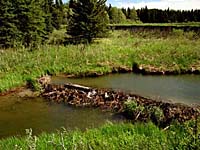
Culverts, hydroelectric dams, and water supply weirs can prevent fish from reaching critical upstream feeding and spawning areas. Water flow through culverts may be too fast for fish to swim through. Properly designed culverts take into account a fish's swimming ability, time of migration, and peak flow rates. Bridges are preferred because they leave stream beds and slopes in their natural state.

Dams for livestock watering and irrigation, seldom make allowances for fish passage. If the dam is low and conditions favorable, fish can sometimes leap over the dam. When flows drop, the downstream side may become too shallow or even dry out, blocking fish migration. Notches in dams can allow fish passage and provide stream flow. Beavers can, by constructing dams, block streams and often change upstream habitat for fish. |
Hydroelectric dams on major rivers have drastically altered habitat in lakes and rivers. Flooding upstream drowns vegetation that in turn consumes oxygen as it decays, suffocating fish and their food supply. It erode shorelines and undercuts banks, releasing silt that coats spawning sites and disrupts migration patterns. Dams also change water quality, quantity and flow regime downstream. | ||